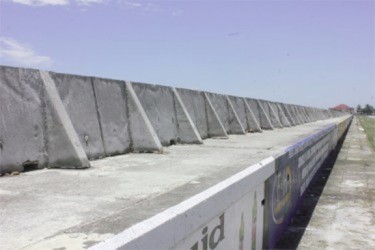With the government’s mobile wave wall seawall extension almost completed along the Rupert Craig Highway from Liliendaal to Kitty the byways, some residents are unsure if it will do the job and have adopted a wait-and-see attitude.
On April 28 this year, monstrous waves crashed over the seawall between Subryanville and Turkeyen, flooding yards with sling mud and stunning residents who had never witnessed such scenes before. A disturbance in the Atlantic was said to have pumped up high tides that were scheduled for that period.
Stabroek News spoke with residents living along the highway in various villages and the consensus was clear; residents are grateful that the Public Works Ministry has initiated projects to help alleviate overtopping but it is unlikely that they will rely on the wall extension alone as their means of protection.

Indra Mekdeci, of Subryanville, told Stabroek News that, “it is left to be seen what will happen.” She added that the last set of rains and overtopping came with such high winds that garbage bins that were anchored down were torn apart. She said that “the ministry was able to act quickly and mobilise the traffic… they did a good job” and the wall construction began quickly after the last set of high tides. Mekdeci said that “it is an ugly wall and we have to wait and see…we don’t know if it will hold.”
Mekdeci was candid when she said that while weather warnings were nice to receive, warnings did rather little to actually prevent flooding for houses along the highway. She told Stabroek News that her home was not as affected as others because the land was built up, however people are not likely to rely on just the protection of a wave wall. She noted that persons who utilised mobile pumps to help move stagnant water would still proceed as they have done for years.
Other Subryanville residents, including the French Consulate, will need to still rely on other preventative methods, like mobile pumps, and physically moving furniture to higher ground. Rosita Katchay told Stabroek News that a mobile wave wall seemed unhelpful. She added that for years engineers have been saying that the seawall had to be heightened or that land had to be reclaimed from the sea but the government has delayed and delayed.
She said, “I don’t know if the wall makes sense,” while noting that since the Public Works Ministry began the construction of the wall, there has been no sign of high tides. Katchay said that she was not aware if the wall should have been constructed along this stretch of the highway because from what she recalled the Ministry of Public Works has stated that the high tide was moving west along the East Coast highway.
Yet another resident in the Ogle area told Stabroek News that residents would still be placing sandbags along the doorways. She said “the real problem for us is the cars. We can move everything upstairs, but the cars when there are floods they can’t be moved anywhere.” She said that “we are still going to pump water, what if the next set of high tide is paired with rains, heavy rains? This is the coast we gon flood.” She continued that drainage and infrastructure had to be a top priority for the city council with the help of the Public Works Ministry. “I am not too impressed with the new wall—it doesn’t look nice—and a new wall doesn’t mean that all that sand isn’t going to clog the drains,” she stated. The Ogle resident told Stabroek News that she understood the ministry had to “appear” to be doing work and “this was the cheaper option, but we can’t be cheap in this case not anymore.”
The wave wall is being constructed at approximately $20 million for a one kilometre stretch and completely funded through the ministry. Previously, project engineer Maitland Stewart had told Stabroek News that the cost was approximately US$100 per metre while a more permanent construction solution would cost US$2,000 per metre. The wall’s construction was more focused on the side facing the ocean. In previous conversations with Stewart and the Public Works Minister Robeson Benn, Stabroek News was told that the wall would help to build back the erosional front which acted as a natural sea defence barrier.
Benn had noted that to spend billions in rip-rap defences made little sense due to movement of the high tides which were moving along the shore. “We aren’t putting a billion dollars in mud when this is going to do the job,” he said.
The project has officially taken double the amount of time that was originally stated. The weather was blamed for the delays as well as design restructuring of the wall.




